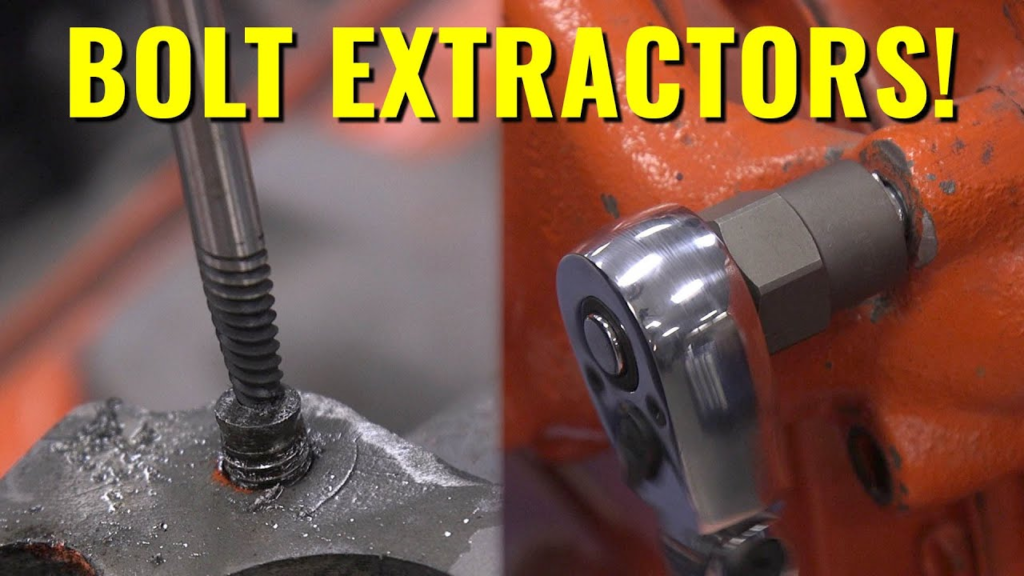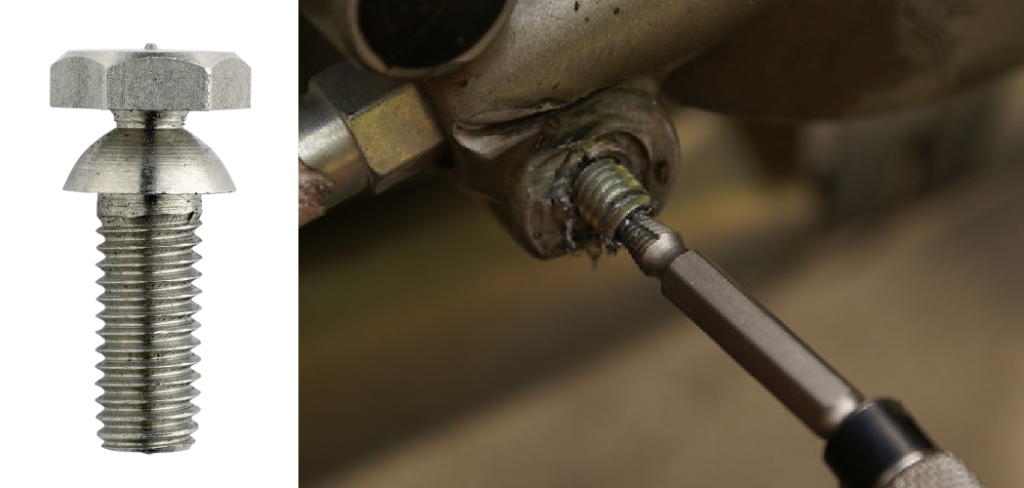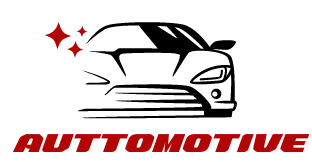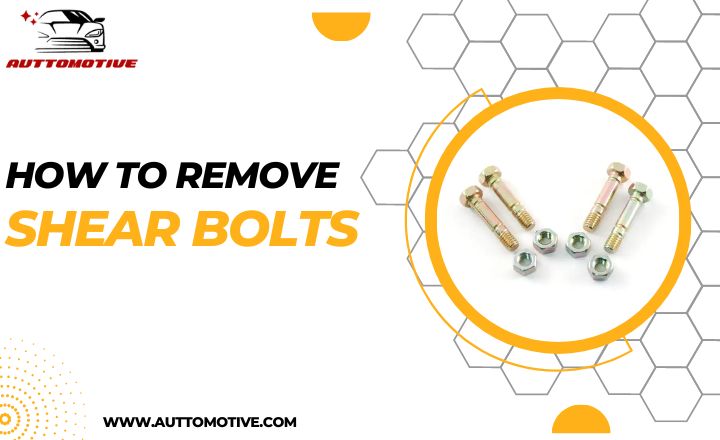Do you need to know how to remove shear bolts? Shear bolts are specially designed fasteners that are used in many applications, and they can be difficult to take off if you don’t know the right technique.
In this article, we will take a closer look at the process of removing shear bolts so you can easily tackle any project involving these fasteners. You’ll learn the best ways to loosen them without damaging the bolt or surrounding components.
How to remove shear bolts?

Shear bolts are a type of fastener that is designed to break under pressure. They are commonly used in machinery and equipment where overloading could cause damage or injury. Shear bolts provide an added layer of safety by breaking at a specific load, preventing further damage to the machine.
Shear bolts come in various sizes and strengths, depending on the application they will be used for. Typically made from high-strength steel or other alloys, they are designed to withstand high loads while still maintaining their integrity. The head of the bolt is typically hexagonal, allowing it to be tightened with a wrench.
When installing shear bolts, it’s important to follow the manufacturer’s specifications regarding torque values and tightening procedures. Over-tightening can cause premature failure of the bolt while under-tightening can compromise its strength and integrity.
Knowing how to remove shear bolts is crucial for anyone who works with machinery as it saves time and effort while preventing further damage.
Tools Needed To Remove Shear Bolts
Strong clamp
A strong clamp that can securely hold the nut in place while it’s being unscrewed. Without this crucial tool, there’s a high risk that the nut will simply spin with no progress being made in removing it.
The ideal clamp for this task should be made from durable materials and have a powerful grip that can withstand pressure without slipping. It should also be adjustable so that it can fit nuts of different sizes and shapes. With such a clamp at your disposal, you’ll find that removing shear bolts becomes much easier and faster than before.
While there are many different types of clamps available on the market today, choosing one specifically designed for holding nuts during unscrewing operations will ensure top-notch performance when working with shear bolts.

Wrench
A standard wrench may not fit the bolt head properly and can cause damage or even breakage during removal. That’s why a specialized wrench designed specifically for shear bolt removal is necessary.
The right wrench will be able to grip onto the bolt head securely without slipping or rounding off the corners. This ensures that enough torque can be applied to loosen and remove the bolt without damaging surrounding parts or tools.
A good quality shear bolt wrench should have a durable construction that can withstand repeated use without breaking or wearing down easily. Investing in a high-quality shear bolt wrench will save you time, money, and frustration in the long run. You’ll be able to quickly and efficiently remove stubborn bolts with ease while minimizing any potential damage or complications.
Hammer
When it comes to removing shear bolts, a hammer can be an essential tool. Shear bolts are designed to break under pressure, protecting your equipment from damage in the event of an overload or jam. When it’s time to replace them, you’ll need a hammer to remove the broken pieces.
To begin, ensure that you have a heavy-duty hammer that’s strong enough to handle the job. You’ll also want to use a punch or chisel to drive out any remaining pieces of the bolt. It’s important not to force the bolt out – instead, tap it gently with your hammer until it begins to move.
Once you’ve loosened the bolt, you can start using pliers or vice grips to pull out the remaining pieces. Be careful not to damage any surrounding machinery or parts while doing so.

Protective gloves
Wearing protective gloves is essential because they provide a barrier between your hands and the sharp edges of the machinery parts. They are made from durable materials that can withstand cuts, punctures, and abrasions from rough surfaces.
Protective gloves also provide better grip and dexterity so that you can work efficiently without dropping tools or injuring yourself. It’s important to wear appropriate clothing when working with machinery. Loose-fitting clothes or jewelry could get caught in moving parts, leading to serious injuries or even death.
Terminate Shear Bolts Operating A Hex Key
Terminating shear bolts operating a hex key can seem like a daunting task, but with the right knowledge and tools, it can be done quickly and efficiently. When working with a hex key to operate these types of bolts, it is important to be aware of how much force you are applying. Too much force will cause the bolt to break prematurely, while not enough force will result in a malfunctioning machine.
Before attempting to terminate shear bolts operating a hex key, it is important to ensure that you have the correct size and type of hex key for your specific bolt. Some bolts may require an Allen wrench or other specialized tools. Once you have the proper tool in hand, make sure that the machine is turned off and any necessary safety precautions are taken before beginning work.

Identify the size of your hex key needed for the job. A larger or smaller size than required may damage or strip the bolt head rendering it useless. Make sure to clean out any debris from around the bolt head to ensure that the hex key fits into it smoothly without slipping off.
Apply some penetrating oil around the edges of the bolt and let it soak for several minutes before attempting removal. Insert your hex key into the center of your damaged or broken-off shear bolt head and twist counterclockwise until it loosens up.
Remove Shear Bolts Using Lubricant
Lubricants are a staple for mechanics, who know better than anyone the importance of reducing friction between two things. Whether it’s bolts and other fasteners or engine components that need to move smoothly against one another, lubricants play an essential role in keeping everything running smoothly. With their ability to reduce wear and tear, prevent overheating, and improve performance overall, it’s no wonder that they’re such a popular choice among those in the automotive industry.
If you find yourself struggling with a stuck bolt or another type of fastener, lubricant can be your best friend. By applying a small amount of lubricant directly to the area surrounding the bolt or nut, you can help reduce friction and make it easier to remove without causing damage. This is especially important when dealing with shear bolts – which are designed to break under pressure – as they can be notoriously difficult to remove without damaging surrounding components.
Remove Shear Bolts Using a Torque Wrench
A torque wrench is an essential tool for any mechanic or DIY enthusiast who wants to ensure that the nuts and bolts on their projects are tightened to the correct specifications. It is a precision tool that helps you apply controlled force to bolts or nuts, allowing you to avoid over-tightening or under-tightening them. This means that your projects will be more secure and less likely to suffer from issues caused by loose parts.
Remove Shear Bolts Using Bolt Extractor

If you need to remove shear bolts, using a torque wrench can make the process much easier and safer. Shear bolts are designed to break off when they reach a certain torque level, which means that removing them without damaging the surrounding components can be tricky. By using a torque wrench set at the appropriate level, you can apply just enough force to loosen the bolt without causing any damage.
If you struggle to remove stubborn shear bolts, a bolt extractor can make the process much easier. There are three key things that you need to consider before using one: diameter, length, and rotation. You’ll need to measure the bolt accurately to ensure that you purchase an extractor of the correct size. If it’s too small or large, it won’t work effectively.
Length is important as a longer extractor will be able to grip onto more of the bolt and provide greater leverage. This is particularly important if the head of the bolt has been sheared off completely and there isn’t much left sticking out for the extractor to grip onto.
Rotation refers to whether the extractor rotates clockwise or counterclockwise. You should choose one that rotates in accordance with how your drill turns as this will help prevent any damage from occurring during extraction.
Remove Shear Bolts By Using A Drill

The most effective and efficient method is by using a drill bit that is slightly larger than the diameter of the bolt itself. This method involves drilling out the center of the bolt until it becomes loose enough to be removed from its position.
To begin with, you will need to gather all necessary tools such as a drill machine, lubricating oil, and safety gear like gloves and goggles. Once you have all these in place, apply some lubricating oil onto the surface of the shear bolt so that it can be drilled easily without breaking or damaging any parts around it.
Carefully align your drill bit with the center of the shear bolt while ensuring that it’s slightly bigger in diameter than the bolt itself. Begin drilling slowly to prevent causing any damage to other parts around it.
Safety Tips for Removing Shear Bolts
Here are some safety tips for removing shear bolts:
- Make sure the equipment is turned off and completely shut down before attempting to remove any shear bolts.
- Wear personal protective equipment such as gloves, safety glasses, and ear protection.
- Inspect the bolt carefully for any signs of wear or damage before attempting removal.
- Use the correct tools for removing the bolt – do not use pliers or other makeshift tools that could slip or break.
- Apply penetrating oil around the bolt thread and let it sit for several minutes before attempting removal.
Conclusion
Removing shear bolts is not a complicated task. With the proper tools and knowledge, anyone can easily remove them from their equipment. Simply ensure the bolts are properly labeled and recorded before removal, then use a wrench or vise-grip to turn the bolt in a counter-clockwise motion until it releases. If you experience difficulty in removing the bolt, use a lubricant or heat to help loosen it.
Frequently Asked Questions
How Do You Remove A Shear Bolt?
Use a wrench. Unscrew the bolt by turning it counterclockwise. Once the bolt is loose, remove it from the shear hole. Ensure that you use the correct size of wrench to fit the head of the bolt so that you don’t strip or damage it. If necessary, use a lubricant such as WD-40 to help loosen stuck bolts.
What Do You Know About Shear Bolts?
Shear bolts are fasteners used to secure two components together. They consist of a head and a threaded shank and are designed to break when a certain amount of torque is applied. This ensures that the connection does not become over-tightened, which can cause damage. Shear bolts are commonly used in automotive applications, such as securing wheels or other parts.
What Grade Of Bolts Are Shear Bolts?
Shear bolts are grade 8.5. They are made of medium carbon alloy steel and have a minimum tensile strength of 150,000 psi. They are designed for use in applications that require high shear strength, such as connecting two parts together. Shear bolts can be used in both static and dynamic applications, making them a versatile fastening option for many projects.
What Kind Of Shear Bolt Is The Strongest?
The strongest type of shear bolt is the hex head bolt. This bolt has a six-sided head that provides greater surface area for a wrench to grip when tightening or loosening it. This increased grip strength makes it harder to strip the threads, making it a more secure fastener.
The round head bolt is also strong but not as strong as the hex head bolt due to its smaller surface area. Its round shape limits the amount of torque that can be applied, which reduces its overall strength and durability compared to the hex head bolt.

